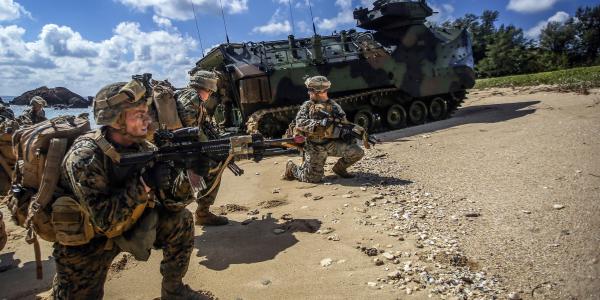Marine Corps Lab Imagines Weapons of the Future
How does the U.S. Marine Corps, which is facing multiple challenges in a changing operating environment, repel daily threats? With sound strategies as well as direction, preparation, doctrine and of course innovation, says one Marine Corps official. However, U.S. enemies, who continue to change and create a unique environment, are also armed with technology.
“Our adversaries continue to evolve and move in different directions much more rapidly than what we have seen in the past,” says Jeff Tomczak, deputy director of the Science & Technology (S&T) Division at the Marine Corps Warfighting Laboratory. “It is presenting a problem to our fighting forces because we are not only facing state actors as a threat, [but] we are facing irregular organizations and hybrid enemies. They are taking advantage of something that enemies in the past have not taken advantage of and that is the proliferation of technology.”
Capabilities that were not easily accessible in the commercial sector years ago—that were once only seen in places such as the Defense Advanced Research Projects Agency (DARPA)—have become readily available to enemies. “The state actors that are out there that did not have access to this technology before now do,” Tomczak exclaims. “The balance has changed. They are getting access to technology, learning how to use it and are employing it against us in different ways.”
The Marine Corps turns to its Warfighting Laboratory to help counter the imbalance. The lab’s divisions—Futures Assessment, Concepts and Plans, Wargaming, S&T, and Experiment—all play a role in shaping future needs, trends and technologies as well as the operating environment the Marines will face. “We are the headlights of the Marine Corps modernization effort,” Tomczak notes. “We are looking out a little further than other Marine Corps offices.”
He shares that the warfighting lab is currently looking into autonomous systems and robotics; artificial intelligence (AI); counter-unmanned aerial system (C-UAS) capabilities; lasers; cyber and electronic warfare; and systems coordination, among other technologies. The lab considers size, weight and power issues “in everything they do,” Tomczak says, to support a mobile, agile Marine Corps.
He confirms that the warfighting lab has been looking at autonomous systems and robotics for quite some time now. “We’ve always recognized that autonomous systems, whether they are in the air, on the ground or at the surface, are going to play a role in the future landscape and future warfighting environment,” Tomczak says.
The big question is how best to incorporate the technology so that it becomes a force multiplier rather than a burden. Naturally, the service wants to avoid robotic technologies without the capabilities it needs to perform specific missions.
Unlike robotics and autonomous systems, AI is an area the lab is just starting to explore. Tomczak recognizes that “we don’t fully understand yet what AI could mean or what it will mean in the future. We do have smart people looking into it, and we do recognize it as an emerging capability that we need to take advantage of it.”
He notes that the Office of Naval Research (ONR) and DARPA have been working on AI for some time. The warfighting lab is supporting ONR’s and DARPA’s AI efforts through engagement opportunities, allowing operational forces to take a look at technologies as the military starts to develop capabilities.
Technologies are especially needed to counter the proliferation of what the Marines are calling “U-Excess,” unmanned aerial, ground, surface and subsurface systems. “We now are living every day with the fact that unmanned aerial systems are flying pretty much everywhere,” Tomczak states. “They are sold everywhere—from Costco to Target to online. And anyone can buy them, which means that any state or person who wants to pose a threat to the United States or to U.S. forces can purchase them.”
He predicts a quick migration to enemy use of unmanned ground systems, surface systems and subsurface systems to threaten U.S forces.
“Envision a future where you have a patrol that is looking for an aerial system, and instead a ground system comes up or is sitting along a trail,” Tomczak relates. “It could be in a sleep mode and camouflaged and then activates based on vibration or voices. Then it does what it is designed to do, which could be a collector to listen to discussions and stay quiet, or it could become basically an improvised explosive device [IED] that explodes, killing soldiers.”
To combat this risk, the warfighting lab is broadening its work in unmanned systems. “Based on our experience from the counter-IED fight, we recognize that as we start to develop capabilities to counter air systems, it is only logical that the enemy will start to look at other capabilities,” Tomczak says. “Our goal is to stay one step ahead and anticipate what is coming.”
The warfighting lab is cultivating directed energy technologies, including lasers, as an important capability to battle the coming barrage of air, ground, surface and subsurface unmanned devices. The lab is working closely with the ONR to develop Marine Corps-specific applications of laser technologies, including lower and higher power options. (See also "Marines Size Up Laser Weapons.")
Given growing threats in the cyber domain, cyber and electronic warfare are of interest to the lab as well, Tomczak says. “We understand the rules and the regulations associated with the application of cyber, and what we are trying to do is to break down the traditional way of thinking. We want to create systems that allow the Marines, down to the lowest levels, to be able to do things that have cyberlike effects on the enemy, when and where they want [them],” he says.
That kind of technology would allow the Marines, for example, to walk into a town or a village and already know where the hot spots are, Tomczak explains. The Marines could potentially shut down these connections in advance and turn them back on when they leave. They also could use these connections to monitor social media and pick up on whether town or village inhabitants are affable or hostile. Having that kind of knowledge in advance helps when “you see people waving to you and smiling, but [they] also are hiding an AK-47 behind their back,” Tomczak says. “It is important for that tactical unit to be able to have immediate effects as they are experiencing them. It could be the difference between life and death and failure and success.”
The warfighting lab will take burgeoning technologies and put them to the test in several experiments throughout the fiscal year, including at three smaller events, which Tomczak calls “limited object assessments” (LOAs), and one larger event. The LOAs are opportunities to put technologies into the hands of operators in the field, along with other lab partners, to gain a common understanding of potential capabilities and technologies.
One LOA will focus on the Marine Corps initiative 21st-Century Fires, looking at firing weapons that are not programs of record but may be of interest in the future. A second LOA will center on cyber and electronic warfare, while a third will take on manned and unmanned robotics. “We will take different robotics systems that are out there, merge them with an operational force and run them on a course multiple times to see what works and what doesn’t work,” Tomczak says, before taking the technologies to bigger events.
One larger event planned for this fiscal year will be held in the spring at Camp Pendleton, California. The event is designed to have more of an industry focus, merging military concepts with industry capabilities. In the next fiscal year, a large LOA event will have an urban focus, representing the nature of a future battlefield. “These experiments are crucial in sorting out useful technologies and capabilities,” Tomczak notes.
The technological renaissance is providing an abundance of options, and with all the technologies that Tomczak sees, he could make a case for each one. But they cannot all be pursued. “The problem is that we can’t afford to buy everything, and the American taxpayers don’t want us to buy everything,” he acknowledges. “My job is to be as unbiased as possible, to give a fair assessment of capabilities and to make recommendations on capabilities that will have the greatest return on our investments.”
The lab has developed processes that allow senior leaders to make smart decisions about the technologies they need for programs of record, the technologies they do not need and the technologies that may be obsolete in three to five years. But making choices can be challenging, he says, because people are swayed by technology and the “bright, shiny new object.
“The hardest part is trying to make sure that the people who are in love with their technologies understand what it is that they are in love with,” he admits. “It is difficult to convince people that, ‘Yes, it is a great capability, but is it greater than this other capability over here?’” Once he shows them the existing technology and asks them to choose between the two, Tomczak says he “can see the lightbulb turn on in their heads, and they say, ‘Oh, now I see.’”
Once people are no longer biased about a technology, there is room for discovery. Tomczak himself has to stay away from championing certain specific technologies to keep from being biased. “Everything we consider has to get a fair shake,” he says. “I have seen technologies that nobody liked that turned out to be pretty effective.” And at the end of the day, when the Marines are kicking in the door, those technologies could make all the difference.






Comments